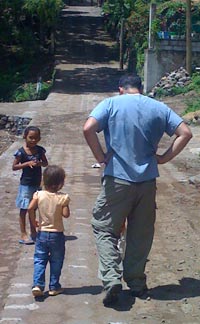For the Class of 2017’s John Weeks, practicing medicine means more than providing care to patients in an exam room. It’s a commitment to caring for an entire community and the challenges it may face.
That’s why after earning his undergraduate degree from the College of William & Mary and spending three years as an outreach worker on Virginia’s Eastern Shore, he enrolled in the VCU School of Medicine where he also was accepted into the International/Inner City/Rural Preceptorship program on the MCV Campus. I2CRP is a four-year program for students who declare an interest in and commitment to working with medically underserved populations in urban, rural or international settings.
“The I2CRP program is one of the big things that drew me to VCU,” says Weeks. “There’s an overall sense that you can really make an impact — improving people’s lives and improving the community they live in. It’s not just serving one patient, treating them, and moving on to the next, but going beyond and helping a whole community.”
 ‘Open your eyes and look around you’
‘Open your eyes and look around you’
In addition to working for the Eastern Shore Rural Health System prior to medical school, he returned during his third-year family medicine clerkship and fourth-year community immersion elective. There Weeks experienced firsthand the challenges of providing effective medical care to an underserved population that included the indigent, elderly and Spanish-speaking migrant farm workers.
For starters, some of the biggest hurdles he saw had very little to do with the medical issues that originally brought patients to the clinic. High blood pressure, diabetes and work-related injuries are further complicated by high levels of poverty, housing and food insecurity, lack of transportation, exposure to pesticides and chemicals, legal problems with immigration status or navigating Medicare.
“People think that to truly find the underserved, you have to go international,” Weeks said. “But that’s just not the case. All you have to do is open your eyes and look around you. The biggest similarity of all underserved populations, regardless of location, is access.”
Serving the Eastern Shore population has particular meaning for Weeks, who grew up in Northern Virginia and appreciated the small, intimate community he met on the shore.
“It was constantly amazing to me how much the people knew each other,” he says. “The outreach worker I partnered with knew not only everyone’s family ties, but where they lived, what they needed and, most importantly, what resources they might be willing to accept to help them through difficult times.”
Weeks received the medical school’s Scott Scholarship, awarded by the Marguerite L. Hopkins Trust and James Perkins Memorial Trust to a deserving medical student from Virginia with preference given to a student with ties to the Eastern Shore.
Marguerite Hopkins grew up on the Eastern Shore and stipulated that some of the funds in her trust should be used to create an annual scholarship named for her cousin, Ralph M. Scott, M’50. Scholarships continue to be a high-priority need for the medical school and donors may outline criteria to select student recipients, including supporting students from a particular geographic region.
‘I want to go someplace and make people healthier’
Approximately 24 students are admitted to I2CRP from each medical school class, said Mark Ryan, M’00, H’03, I2CRP medical director and assistant professor in the Department of Family Medicine and Population Health. “Our students are amazing. They have diverse experiences and diverse backgrounds but a similar sense of ‘I want to go someplace and make people healthier where otherwise they would have struggled.’”
Since its first graduating class in 2000, 37 percent of I2CRP graduates have gone on to practice in family medicine with nearly a third of those practicing in rural areas. All told, 85 percent of graduates enter careers in the National Health Service Corps priority fields of family medicine, internal medicine, pediatrics, combined internal medicine-pediatrics, OB-GYN, psychiatry and general surgery.
I2CRP director Mary Lee Magee attributes much of the program’s success to its curriculum that spans all four years of medical school, starting with electives in the spring semester of M1 and ending with a month-long community immersion during M4. Along the way, students share their experiences with their peers and faculty members.
“Our retention rate is very strong,” she says. “The program offers meaningful opportunities for critical thinking, reflection, mentorship and community building that are essential to support careers in underserved communities.”
That support is designed to go beyond graduation, Ryan says, when the challenges of caring for the underserved can become trying.
“Patients can’t fill prescriptions, can’t get to appointments, don’t have the same language as their physicians,” he says. “There will be times when it feels very hard to sustain and it’s important to have a support system to lean on. Hopefully through I2CRP, John and others will develop a network of peers, physicians and faculty who they can ask for advice and connect with when that time comes.”
It’s advice Weeks takes to heart as he applies for a family medicine residency with the ultimate goal of working “where people need me.”
“Find the little victories,” he says. “Some patients have a million obstacles lying in their path but if you can remove one or some of those obstacles, it’s huge. Every piece of the puzzle matters and once you start putting it together and help people get healthy, you realize everything you do, no matter how big or small, can be really rewarding.”
By Polly Roberts

